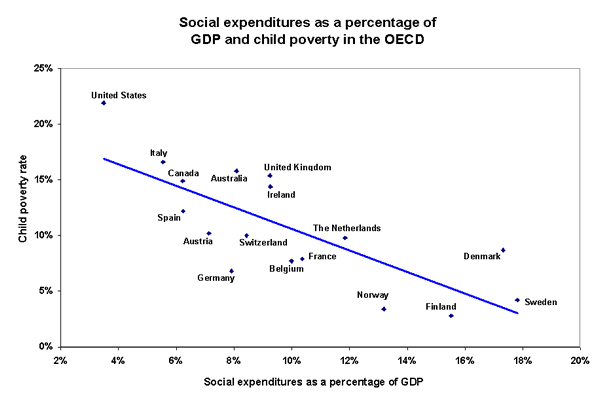See Snapshots Archive.
This Snapshot is a sneak preview of information compiled in the forthcoming EPI book The State of Working America 2004/2005.
Snapshot for June 23, 2004.
Social expenditures and child poverty—the U.S. is a noticeable outlier
All advanced industrialized countries make an effort to reduce the number of children who live in poverty, but poverty remains a harsh reality for many children in every country. Child poverty is defined as children living in households where income is less than 50% of household median income within each country. Although children bear no responsibility for living in poverty, they are penalized not only in childhood but later in life if their health or education suffers from a lack of resources.
All economies face the trade-off between how much money should be spent and what level of childhood poverty is acceptable. The data used in the figure below compare social economic expenditures and child poverty rates of the United States to that of 16 other rich, industrialized countries that, like the United States, belong to the Organization for Economic Cooperation and Development (OECD). The United States and these other countries face similar global conditions with respect to trade, investment, technology, the environment, and other factors that shape economic opportunities. Thus, this comparison provides a yardstick for gauging the commitment of the U.S. government to reducing child poverty and its lifelong effects.

The figure clearly illustrates that those countries with higher social expenditures — as a percentage of gross domestic product, or GDP — have dramatically lower poverty rates among children. The blue line in the figure shows the correlation between expenditures and child poverty rates for all countries. Individually, the Nordic countries — Sweden, Norway, and Finland — stand out, with child poverty rates between 2.8% and 4.2%. The United States stands out as the country with the lowest expenditures and the highest child poverty rate — five times as much as the Nordics.
The paucity of social expenditures addressing high poverty rates in the United States is not due to a lack of resources — high per capita income and high productivity make it possible for the United States to afford much greater social welfare spending. Moreover, other OECD countries that spend more on both poverty reduction and family-friendly policies have done so while maintaining competitive rates of productivity and income growth.
Source: Author’s analysis of OECD and Luxembourg Income Study data.
This Snapshot was written by EPI economist Sylvia A. Allegretto.
